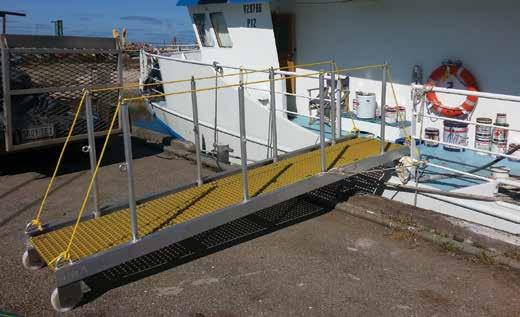
2 minute read
Safe Access to vessels
By Brad Roberts and Brad Milic
Vessel owners and masters must provide a safe way of getting on and off vessels to reduce the chance of people falling and injuring themselves, or even drowning. This is a requirement under the national law general safety duties.
Advertisement
The requirement for safe access is often overlooked, particularly where there are limited berthing options, or a vessel is only berthed for a short period. Failing to provide safe access can result in a serious incident—even more so when bad weather or extreme tidal variation are thrown into the mix.
In addition to national law requirements, commercial vessels need to address risks associated with falls under state and territory workplace health and safety regulations, including falls sustained getting on and off a vessel.

Safety plus: A safe, purpose-built boarding platform onto a prawn trawler at North Arm, Adelaide.
Managing the risks
1. Assess the risks—What are they? What could make them worse? What could happen to a person as a result of this? How bad would the impact be?
2. Implement ways to control those risks. These might include:
• Building a safe gangway
• Limiting access in bad weather and if necessary, during extreme tidal variations.
• Providing lighting around the gangway at night to increase visibility.
• Securing gangways clear of the wharf edge, or other potential hazards.
• Including instructions on when and how to safely board the vessel—and when not to—in your crew safety inductions. Under the general safety duties, crew and passengers must follow this instruction.
• Encouraging your crew to report hazards associated with getting on and off the vessel.
• Developing emergency procedures for any possible incidents associated with getting on or off the vessel ie falls, man overboard.
• Documenting these risks and controls in your safety management system and reviewing them periodically to make sure they are still relevant and practical.
Unsafe access can have tragic consequences
A man tragically lost his life in the process of climbing down on to a barge in Darwin, Northern Territory in 2017.
The 34-metre barge was moored at a different location than usual, and although a gangway was available, the crew—who lived aboard the barge—simply jumped onto a tyre secured to the wall and climbed up onto the wharf. One crew member attached a length of rope to help crew climb back onto the vessel—only it wasn’t enough.
With no gangway in place to bridge the gap, one of the crew lost his balance when climbing between the barge and the wharf; and fell into the water. The crew member was found dead in the water the next morning.
Following the NT Worksafe investigation and ensuing court case, the operator was fined $190,000, while the master was fined $20,000. But the real cost was the loss of the man’s life, the irreplaceable loss suffered by the man’s family and the personal impact on co-workers.

Unsafe: Unacceptable access to a vessel.
Crime Scene Examination Unit, Northern Territory Police










